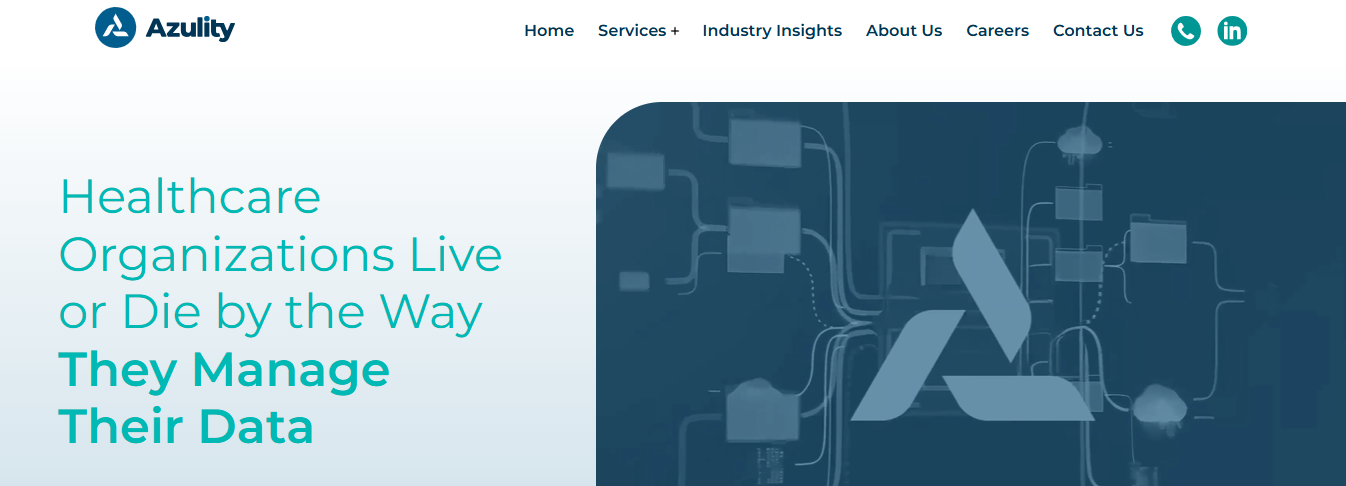Credentialing can feel like a never-ending maze. You’re stuck waiting on a mountain of paperwork before you can start seeing patients, and every day that passes feels like a lost opportunity for your practice.
The average time it takes to complete provider credentialing is about 3 months, but this time can vary based on several factors, including how well your practice manages the steps involved. This guide will help you understand these steps and how to speed up the process so practitioners can see patients faster.
Azulity’s provider credentialing services can help you achieve these goals with innovative data management solutions to allow your practice. Our services simplify the provider credentialing process to help you get practitioners to see patients faster.
Importance of Credentialing in Healthcare


1. Builds Trust in Patients
Patients’ mental state can significantly affect their recovery. When patients trust their healthcare provider, they’re more likely to follow instructions and remain calm during treatment. For instance, patients who need cardiac surgery will be more inclined to follow pre-op directions if they trust their surgeon. This trust can also positively impact clinical outcomes.
Additionally, adequately credentialed medical professionals boost patient confidence and promote staff retention. Physicians, nurses, and other healthcare workers desire to work in environments where they can trust their colleagues. Highlighting the credentials of your organization’s staff and openly sharing this information with patients can help instill confidence in your practice.
For example, the Cleveland Clinic prominently displays its physicians’ credentials, including education, certifications, and specialties, on its website. This transparency reassures patients that they are receiving care from highly qualified professionals. For example, patients requiring cardiac surgery may feel more confident knowing their surgeon completed a fellowship at a leading institution, such as the Mayo Clinic.
2. Demonstrates Your Professionalism
In healthcare, it’s essential to show your professionalism with verifiable evidence. Taking the time to complete the paperwork required to show your credentials is a small price to pay for assuring patients of your bona fides. Healthcare Innovation noted, “Through a standardized process involving data collection, primary source verification, and committee review by health plans, hospitals, and other healthcare agencies, patients are assured of their healthcare professional’s merit and experience.”
In the past, medical professionals may have balked at credentialing because of all the paperwork they’d have to wade through. However, modern methods allow much of this information to be handled online. Check that your team can use electronic credentialing for any entities that want to check your standing, such as before you start a contract with another organization or before any hospital can allow you to become an affiliate. Details include where you went to medical school, your internship or residency location, your board certifications, and your curriculum vitae.
Of course, you’ll also note information about your malpractice insurance and current, valid medical license. The Mayo Clinic’s credentialing process ensures that all its healthcare professionals meet rigorous standards. For example, before a new specialist joins the team, they must provide proof of board certification, training, and licenses. This professionalism strengthens patient trust and enhances the clinic’s reputation as a leader in medical care.
3. Necessary for Compensation
You’ll need to be medically credentialed, as this is required for reimbursement from insurance companies. Getting the documentation finished promptly ensures that a new nurse or doctor you’ve hired can begin providing services on hiring day. To that end, many organizations will require applicants to have their documentation set up well beforehand.
It’s not a task to put off, and the time frame can vary from state to state because of differences in regulations and credentialing laws. Private health insurance companies like Medicare and Medicaid will want proof of medical credentialing before allowing your staff to engage with patients.
Kaiser Permanente requires all healthcare providers, including nurses and physicians, to complete credentialing before they can treat patients and bill insurance. This ensures smooth reimbursement processes from Medicare, Medicaid, and private insurers. For example, a newly hired primary care physician in California who completed their credentialing before their start date can begin consultations without delays in compensation.
4. Reduces Medical Errors
When healthcare professionals obtain proper medical credentials, it helps to support the safety and security of the entire industry. Medical errors are implicated in 98,000 deaths in America (per Healthcare Innovation’s report), making the importance of medical credentialing clearer. Patients have a right to trust that their healthcare providers know what they’re doing and are working in a safe and approved fashion.
The Veterans Health Administration (VHA) mandates stringent credentialing and privileges for all medical professionals in its facilities to reduce errors. For instance, a surgeon performing procedures at a VA hospital must have their training, certification, and experience thoroughly vetted to prevent unqualified individuals from operating.
5. Helps Maintain Adequate Staff Levels
If you’ve been having problems maintaining the requisite staff levels to serve your local community, medical credentialing is essential to fill out your team. New medical staff candidates who aren’t coming from a job placement company (that would help them with credentialing) should get started with medical credentialing as early as possible. It could take as many as four months to complete. To help pave the way, create resources such as a credentialing packet to give to all new hires. It will support them through the application process.
Your human resources department would be well advised to track all candidates’ medical credentialing status and identify any obstacles that could delay onboarding new hires. Banner Health uses a dedicated credentialing team to expedite the onboarding process for new hires. For example, during the COVID-19 pandemic, this system allowed the organization to rapidly credential travel nurses and additional healthcare staff, ensuring no service gaps.
Related Reading
How Long Does Credentialing Take


Credentialing: How Long Does It Take to Get Verified?
The credentialing process for healthcare providers typically takes 30 to 90 days. However, depending on the case’s complexity and the organization’s efficiency in conducting the credentialing, it can extend beyond 120 days in some cases.
What Factors Affect Provider Credentialing Times?
Several variables affect the time it takes to verify a provider’s credentials. Here are some of the most common:
1. Completeness and Accuracy of Application
Please include documents, such as licenses, malpractice insurance, or employment history, to avoid delays. Application errors may require corrections and re-submissions.
2. Provider’s Background
Providers with extensive employment histories or multiple licenses require more verification steps. Malpractice claims, disciplinary actions, or criminal records can prolong the background check.
3. Verification Process
Credentialing involves verifying information directly with primary sources (e.g., medical schools, licensing boards, previous employers). This step is time-intensive and varies based on the responsiveness of these entities.
4. Specialty and Scope of Practice
Some specialties may require additional certifications, hospital privileges, or specific training verifications, which can take longer.
5. State Licensing Boards
State processing times vary widely; some states take weeks or months to confirm licenses.
6. Insurance Credentialing
Credentialing with insurance payers (e.g., Medicare, Medicaid, private insurers) often requires separate approvals, each with its timeline.
7. Credentialing Committee Meetings
Applications may need approval during periodic meetings, held only monthly or quarterly.
8. Volume of Applications
Organizations experiencing a high influx of credentialing requests, especially during peak hiring seasons, may need more time.
9. Communication Delays
Slow responses from references, educational institutions, or previous employers can significantly impact the timeline.
10. Background Checks and Compliance
More thorough checks are needed for malpractice claims, criminal history, or disciplinary actions. Ensuring compliance with standards set by accrediting bodies (e.g., The Joint Commission, NCQA) can add complexity.
11. Provider Updates During the Process
Any updates (e.g., change in practice location, new certifications) during credentialing may require re-evaluation, extending the timeline.
12. Technology and Tools Used
Organizations with modern credentialing software systems tend to process applications faster than those relying on manual methods.
Azulity specializes in healthcare master data management and provider credentialing services, bringing proven expertise in implementing healthcare data solutions and credentialing across the US. Our comprehensive platform ensures consistent patient, provider, location, and claims data synchronization across all systems and departments.
Key features include healthcare MDM, provider MDM, reference data management, credentialing, and provider enrollment. We serve healthcare technology leaders from CIOs and CDOs to VPs of data platforms and credentialing, helping them eliminate the costly problems of fragmented data systems. Book a call to learn more about our healthcare master data management services today!
12 Tips for Faster Credentialing in Healthcare


1. Leverage Azulity for Efficient Credentialing


Azulity specializes in healthcare master data management and credentialing services. Their comprehensive platform ensures consistent patient, provider, location, and claims data synchronization across all systems and departments. Key features include healthcare MDM, provider MDM, reference data management, credentialing, and provider enrollment.
Azulity serves healthcare technology leaders – from CIOs and CDOs to VPs of data platforms and credentialing – helping them eliminate the costly problems of fragmented data systems. Book a call to learn more about their healthcare master data management services today!
2. Start Early and Plan
One of the most essential tips for medical credentialing success is to start early and plan. Credentialing can take several months, depending on the state and the insurance company. Therefore, start the process as soon as possible, preferably before opening a new practice or changing states. To start early and plan, you must create a timeline and a checklist of all the required documents.
3. Establish an Escalation Plan
A clear escalation plan is essential to address delays and roadblocks in the credentialing process. This plan involves defining the steps to take when a payer’s representative is unresponsive or unable to resolve an issue. For example, if calls are repeatedly routed to a call center without resolution, you should request a transfer to a supervisor or a US-based office.
For persistent challenges, visiting a local office in person can be effective. This strategy shows that you are serious about resolving the matter, ensuring quicker responses from the payer’s team. However, reserve these measures as a last resort, as maintaining a polite and persistent relationship with your assigned enrollment analyst often yields better results.
4. Gather and Organize All the Necessary Documents
Another tip for medical credentialing success is to gather and organize all the necessary documents. Credentialing requires many documents, such as licenses, certifications, etc. You must ensure you have all the documents ready and up-to-date before applying for credentialing. You can use cloud storage, software, or a binder to keep your documents in one place. You must also regularly check and update your records to ensure they are accurate and valid.
5. Maintain Key Contacts
Building relationships with individuals at insurance companies can significantly speed up credentialing. Direct access to a network of contacts, including enrollment supervisors or regional representatives, is a valuable asset. Leveraging their knowledge and connections can provide a distinct advantage for organizations with employees who previously worked at these companies. Knowing who to call and establishing rapport with decision-makers can help cut through bureaucratic delays, ensuring timely responses and issue resolution.
6. Persistence is Key
The ability to remain persistent yet professional is critical in navigating credentialing delays. Regional insurance representatives are often in their offices only on certain days, so scheduling meetings during their availability or visiting unannounced can help. If direct meetings are not possible, leaving detailed notes addressed to them and copying their supervisors can push your case forward. Demonstrating persistence in a respectful manner conveys that you are determined to achieve a resolution, even when the payer may not initially prioritize your request.
7. Choose the Right Insurance Companies and Networks
A third tip for medical credentialing success is to choose the right insurance companies and networks. Different insurance companies and networks have different credentialing requirements and processes. You must research and compare the available insurance companies and networks in your area that suit your practice’s needs and goals. To choose the right insurance companies and networks, you need to contact them for more information and guidance on their credentialing procedures.
8. Leverage Insider Knowledge
Understanding each payer’s specific rules and requirements is invaluable in avoiding unnecessary delays. Each insurance company has unique credentialing processes, and being well-versed in their policies allows you to submit accurate and complete applications. This proactive approach speeds up the process and minimizes the risk of rejections due to missing or incorrect information. Familiarity with these nuances gives you the upper hand when navigating complex or challenging credentialing cases.
9. Fill Out the Applications Carefully and Completely
A fourth tip for medical credentialing success is to fill out the applications wholly and carefully. Filling out the applications correctly and thoroughly saves you time and avoids errors and delays. To complete the applications, you need to use online applications or electronic forms whenever possible. This can reduce paperwork and speed up the process.
10. Consider Outsourcing
Outsourcing the credentialing process to a specialized service can be an effective solution for practices dealing with high volumes of applications or complex cases. Credentialing firms often have established systems, industry contacts, and experienced teams that can navigate the process more efficiently than in-house staff. By entrusting this task to experts, you free up valuable time and resources while ensuring that credentialing is handled precisely and quickly.
11. Follow Up and Track the Progress
A fifth tip for medical credentialing success is to follow up and track the progress. Following up and monitoring the progress of your credentialing process can help you avoid missing deadlines or losing documents. To follow up and track the progress, you need to use a tracking system or software that can help you keep track of your credentialing process. You can also contact the insurance companies or networks regularly for updates or feedback on your credentialing process.
12. Engage in Strategic Advocacy
Advocating for your case strategically can yield surprising results, especially when dealing with closed panels or unfair denials. Creative approaches, such as presenting compelling justifications for joining a closed panel, can persuade payers to reconsider. Similarly, robust credentialing policies and proactive communication can address and eliminate recurring denials. Taking the time to advocate effectively demonstrates your commitment to navigating these challenges and achieving the best outcomes for your organization.
Healthcare Credentialing Mistakes to Avoid


1. Overlooking the Importance of a Sufficient Workforce for Credentialing Tasks
Credentialing, also known as provider or physician credentialing, requires a lot of work and the help of a team. An organization must verify all licenses and certifications of every practitioner who will provide patient care. For larger organizations like hospitals and health systems, this could mean credentialing hundreds or thousands of practitioners. Relying on limited staff and resources can lead to lost revenue and costly mistakes.
2. Submitting Incomplete Enrollment Applications
Provider enrollment applications require a significant amount of information. Even one missing piece of information can delay processing and reimbursement. To avoid costly setbacks, organizations must ensure that every application is complete and accurate before submission.
3. Allowing a Physician to Treat Patients Before Credentialing is Complete
Hospital credentialing won’t just protect your organization financially; it will also protect your patients. In the past, courts have held hospitals liable when a physician with falsified credentials was allowed to treat patients before the hospital completed its due diligence with proper credentialing. In one of the earliest negligent credentialing cases, a Wisconsin hospital was eager to book surgical cases and failed to verify a surgeon’s credentials properly. Unfortunately, the surgeon provided false information on the application, and the hospital’s failure to detect it led to patient harm when hip surgery went awry.
4. Not Updating and Verifying Information
According to federal and state laws, Healthcare practitioners must renew their licenses and credentials regularly. Initial credentialing and re-credentialing help ensure that healthcare providers are current with their board certifications and licenses. When a hospital fails to stay on top of re-credentialing, it can lead to healthcare providers and facilities performing services needing to be certified or licensed. This creates the potential for adverse patient outcomes, leading to expensive malpractice lawsuits.
5. Covering Up Prior Adverse Action
Failing to disclose an adverse action is a severe oversight by any provider. However, it is also the responsibility of a healthcare organization to conduct screenings for prior disciplinary actions with a thorough background check. Hospitals and healthcare organizations must verify credentials against databases such as exclusion, sanction, and debarment lists. Using a trusted source that pulls data from primary sources is essential.
6. Failing to Report Adverse Actions
Similar to mistake number 5, providers are required to report adverse actions, such as:
- License revocation
- Exclusion from third-party programs
- Suspension or voluntary relinquishment of medical staff membership, clinical privileges, or state or federal licenses
Hospitals and health systems are accountable for a provider’s omission. Therefore, due diligence requires background checks to identify current and historical adverse actions.
7. Failing to Report Adverse Actions to the National Practitioner Data Bank (NPDB)
Providers and organizations that fail to report negative actions to the NPDB withhold critical information other organizations need to complete medical credentialing. The NPDB requires reporting of the following actions:
- Medical malpractice payments
- Federal and state licensure and certification actions
- Adverse clinical privileges actions
- Adverse professional society membership actions
- Negative actions or findings by private accreditation and peer review organizations
- Healthcare-related criminal convictions and civil judgments
- Exclusions from participation in a federal or state healthcare program, including Medicare and Medicaid exclusions
- Other adjudicated actions or decisions
8. Overlooking the Importance of Peer Reviews in Credentialing
Information provided in a peer review or investigation should be taken seriously and evaluated as part of the credentialing process. Peer references can shed light on the capabilities and competencies of a provider that you cannot glean from simply checking education, training, or license status.
Related Reading
- Credentialing and Privileging
- How Much Does Credentialing Cost
- Types of Credentialing in Healthcare
- Hospital Credentialing Requirements
- Primary Source Verification Credentialing
- Provider Enrollment and Credentialing
Book a Call to Learn More About Our Provider Credentialing Services
Healthcare organizations depend on provider credentialing for day-to-day operations. Hospitals and health systems must verify medical staff’s education, training, and experience before they can deliver care. This process eliminates errors and reduces patient risk. However, completing it can take a long time, often several months. According to a 2021 report from the American Academy of Family Physicians (AAFP), the average time for credentialing is 119 days.
The AAFP found that over one-quarter of practices surveyed reported it takes over 150 days. Credentialing a single provider takes an average of 3 months, but in some cases, it can take upwards of a year. This lengthy process delays patient access to care and increases practices’ costs. The AAFP also reported that obtaining the necessary documents to begin credentialing can take up to 60 days. The longer it takes to complete credentialing, the more disruptions there are in patient care and practice operations.
The Importance of Data Management in Health Care Credentialing
Credentialing and enrollment processes generate significant data that must be carefully tracked and managed. Healthcare organizations utilize this data to assess a provider’s qualifications and determine their level of competency to deliver care. As you can consider, the more accurate and complete these data sets are, the better.
Missing or outdated information can lead to incorrect assumptions about a provider’s background and costly errors that jeopardize patient safety. Azulity’s healthcare master data management services help organizations eliminate fragmented data sets that can complicate credentialing and enrollment processes.
